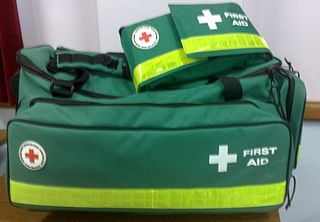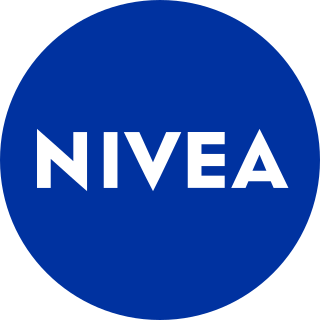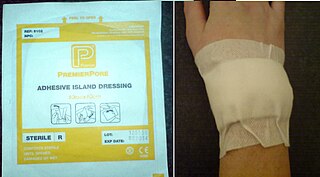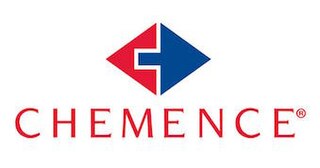
Band-Aid is a brand of adhesive bandages distributed by the consumer health company Kenvue, spun off from Johnson & Johnson in 2023. Invented in 1920, the brand has become a generic term for adhesive bandages in countries such as the United States, Canada, Australia, and others.

Impetigo is a contagious bacterial infection that involves the superficial skin. The most common presentation is yellowish crusts on the face, arms, or legs. Less commonly there may be large blisters which affect the groin or armpits. The lesions may be painful or itchy. Fever is uncommon.

Johnson & Johnson (J&J) is an American multinational pharmaceutical, biotechnology, and medical technologies corporation headquartered in New Brunswick, New Jersey, and publicly traded on the New York Stock Exchange. Its common stock is a component of the Dow Jones Industrial Average, and the company is ranked No. 40 on the 2023 Fortune 500 list of the largest United States corporations. In 2023, the company was ranked 40th in the Forbes Global 2000. Johnson & Johnson has a global workforce of approximately 130,000 employees who are led by the company's current chairman and chief executive officer, Joaquin Duato.

A first aid kit or medical kit is a collection of supplies and equipment used to give immediate medical treatment, primarily to treat injuries and other mild or moderate medical conditions. There is a wide variation in the contents of first aid kits based on the knowledge and experience of those putting it together, the differing first aid requirements of the area where it may be used, and variations in legislation or regulation in a given area.

A blister is a small pocket of body fluid within the upper layers of the skin, usually caused by forceful rubbing (friction), burning, freezing, chemical exposure or infection. Most blisters are filled with a clear fluid, either serum or plasma. However, blisters can be filled with blood or with pus.
Bose Corporation is an American manufacturing company that predominantly sells audio equipment. The company was established by Amar Bose in 1964 and is based in Framingham, Massachusetts. It is best known for its home audio systems and speakers, noise-canceling headphones, professional audio products, and automobile sound systems. Bose has a reputation for being particularly protective of its patents, trademarks, and brands. The majority owner of Bose Corporation is the Massachusetts Institute of Technology. Non-voting shares were donated to MIT by founder Amar Bose and receive cash dividends. The company's annual report for the 2021 financial year stated that Bose Corporation's yearly sales were $3.2 billion, and the company employed about 7,000 people.

An adhesive bandage, also called a sticking plaster, sticky plaster, medical plaster, or simply plaster in British English, is a small medical dressing used for injuries not serious enough to require a full-size bandage. They are also known by the genericized trademarks of Band-Aid or Elastoplast.

Orthopedic casts or just casts are a form of medical treatment used to immobilize and support bones and soft tissues during the healing process after fractures, surgeries, or severe injuries. By restricting movement, casts provide stability to the affected area, enabling proper alignment and healing of bones, ligaments, and tendons. They are commonly applied to the limbs but can also be used for the trunk, neck, or other parts of the body in specific cases. Orthopedic casts come in various types and designs, tailored to the nature and severity of the injury, as well as the patient's needs. Advances in medical techniques have made casts more comfortable, effective, and versatile, allowing for both weight-bearing and non-weight-bearing options.

Nivea is a German personal care brand that specializes in skin and body care. It is owned by the Hamburg-based company Beiersdorf Global AG. This was the origin of the Eucerin brand. Nivea comes from the Latin adjective niveus, nivea, niveum, meaning "snow-white".

A dressing or compress is a piece of material such as a pad applied to a wound to promote healing and protect the wound from further harm. A dressing is designed to be in direct contact with the wound, as distinguished from a bandage, which is most often used to hold a dressing in place. Modern dressings are sterile.

A mustard plaster, also known as a blister, is a poultice of mustard seed powder spread inside a protective dressing and applied to the body to stimulate healing. It can be used to warm muscle tissues and for chronic aches and pains. It was once part of conventional medical treatment, and available in prepared versions in pharmacies. It fell from favor in the 20th century and is now used only as a home remedy.

Balsam of Peru or Peru balsam, also known and marketed by many other names, is a balsam derived from a tree known as Myroxylon balsamum var. pereirae; it is found in El Salvador, where it is an endemic species.
A hydrocolloid dressing is an opaque or transparent dressing for wounds. A hydrocolloid dressing is biodegradable, breathable, and depending on the dressing selected, may adhere to the skin, so no separate taping is needed.
BowFlex is the brand name for a series of fitness training equipment, marketed and sold by BowFlex Inc., formerly Nautilus, Inc. Based in Vancouver, Washington, the company sells its products through direct, retail, and international channels. The first BowFlex product, BowFlex 2000X, was created in 1986. BowFlex products now range from cardio machines, adjustable dumbbells, and home gyms.

Savlon is a brand of antibacterial personal care products with the active ingredients of cetrimide and chlorhexidine gluconate. Commonly sold as a cream, the product range also includes antiseptic sprays, sticking plasters and other antiseptic products.
Coloplast A/S is a Danish multinational company that develops, manufactures and markets medical devices and services related to ostomy, urology, continence, and wound care.
A coma blister, or coma bullae, is a skin lesion or blister that typically arises due to pressure in an individual with impaired consciousness. They vary in size, ranging from 4 to 5 centimeters in diameter, and may appear hemorrhagic or blood filled. Coma blisters are usually found in the extremities and trunk. These types of blisters have been associated with the overdose of central nervous system (CNS) depressants especially barbiturates, but also tricyclic antidepressants, hypnotics, benzodiazepines, opiates, antipsychotics, and alcohol. However, studies have found that coma blisters are not caused by the toxicity of these drugs, but due to hypoxia and external pressure on the comatose individual's skin from being immobilized. Coma blisters have been frequently found on individuals who have overdosed on drugs, but have also been found on individuals with chronic kidney failure, hypercalcemia, diabetic ketoacidosis, and a variety of neurologic conditions. Coma blisters are more frequent in adults and less common among children as demonstrated by the few cases published in literature.
In the UK Pharmaceutical business a Special Obtain is a product which is listed in the Chemist and Druggist Directory or Drug Tariff which is not stocked by the mainline wholesalers.

Johnson's Baby is an American brand of baby cosmetics and skin care products owned by Kenvue. The brand was introduced in 1893 with Johnson's Baby Powder. The product line consists of baby powder, shampoos, body lotions, massage oil, shower gels and baby wipes.

Chemence is a speciality chemical and medical device manufacturer which products include cyanoacrylate adhesives, anaerobic adhesives, impregnation sealants, adhesive activators, epoxy resins, UV adhesives, photopolymer resins, custom printer ink cartridges, Gas pipe sealants, and soak off nail polishes. Chemence is a supplier of photopolymer and commercial printers to the flexographic industry in the US and Europe, as well as the primary sealant supplier to British Gas, and a primary supplier of private-label adhesives to companies including Tesco, 3M, Bostik, and Bondo. The company's catalogue of patents includes processes, packaging devices, and chemical combinations.













